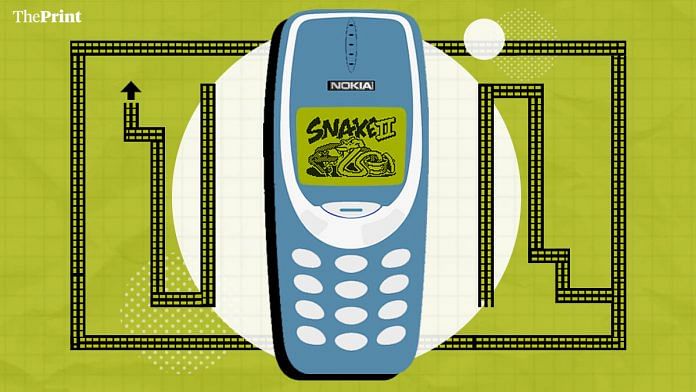With the evolution of graphics, internet access and phone storage, today’s mobile gaming industry offers you a whole arcade in the palm your hand. But PUBG, Temple Run, Flappy Bird, Candy Crush and so many other popular games owe it all to one animated reptile slithering around on a two-inch screen.
An addictively simple game, Snake was launched, in its mobile phone avatar, in 1997 with the Nokia 6110 — you remember, the blue candy bar-shaped model with a single antenna. It followed the basic idea of an elongating reptilian creature that moved faster as it consumed more dots (food) on the screen, but died if it collided into itself.
It is considered to have signalled a new era in mobile gaming, an industry estimated to top $100 billion this year in revenues. However, it was actually the game’s second version that became a household name.
Snake II was launched with Nokia’s 3310 in 2000 and it became an entire generation’s obsession. The snake wasn’t just a line anymore, but had a proper form, there were bonuses and the screen was cyclical, allowing one to go through the bottom of the screen and come back out the top. In India and across the world, kids were hooked, eagerly competing for the highest score whether they were lying in bed, pretending to study in class or sitting at a café. Draining a phone’s battery and earning the wrath of exasperated teachers was just collateral damage.
Pranav Sunderesan, a 23-year-old philosophy graduate, tells ThePrint he’e been playing video games for the past 15 years. He says, “I remember playing Snake II when I was as young as four or five. I would play it on my mom’s old Nokia during car rides home from school. Snake just challenges the most primal part of you. You see it growing with each thing it eats and you can’t help but keep going.”
Vallabh Mamidipudi, a 27-year-old mobile game developer in Hyderabad, remembers how he and his cousins would fight for a turn on a single phone. “If I had to think about it, why fight at all, especially over such a simple game? [But] it’s just that,” he recalls. “When things are simple, you feel like if you just fix a mistake or two, you build a longer snake. It creates the ‘just one more game’ mentality that feeds into addiction.”
It’s true that what made the game interesting was that as the snake became longer, its speed and the difficulty of manoeuvering it across the screen increased, and this was probably the key to the game’s addictive quality and reason why, at one point, it was embedded in about 350 million Nokia phones worldwide. But there was also a science behind the levels of difficulty so as to not discourage a player.
Apparently, Finnish creator Taneli Armanto deliberately added a delay of “just a few milliseconds, right before the player crashes” to give them some extra time to change directions. There were no delays at the hardest level, of course, and that buzzing sound that signalled ‘Game Over’ is one that many millennials, who acquired their first mobile phone when they joined college in the early 2000s, still recall with a rueful grin.
Also read: Planet M — brand that changed how Indians experienced music in new millennium
Where Snake came from
The concept of Snake originated from the 1976 arcade game Blockade, developed by a British company called Gremlin Interactive, which shut down in 1984. Blockade was designed as a two-player game in which each would guide their own snakes, leaving a solid line behind them. The line acted as a blockade and the player who lasted longer was the winner. The basic concept also spawned other games like Nibbler, Rattler Race and Worm.
In fact, Tetris was supposed to be launched with Nokia 6110. Armanto said he even implemented and tested it, but claims that The Tetris Company wanted a share of each handset sold and Nokia wasn’t keen to base any payments on exact numbers of sold products. He then had to come up with something different that fit the specifications of the 6110 model — namely, a very small screen, just a few keys to control the game and not too much programming memory space available. And so Snake was born.
In 2005, Armanto won a special reward from the Mobile Entertainment Forum for his contribution to the growth of the mobile entertainment industry.
The game then went through an entire evolution. Snake Xenzia, released in 2005, shifted to a red-and-white colour scheme, while Snake EX featured a reptile that could even open its mouth while eating. Next came Snake 3D, released in the mid-2000s, whose lead star resembled Kaa from The Jungle Book. The background was also leagues ahead of the original plain green screen — a lush green lawn with shrubbery and fruit instead of dots.
However, it is argued that the quality of Snake declined with Nokia’s now discontinued mobile operating system, Symbian, and its collaboration with Microsoft was the final nail in the coffin.
But all is not lost. Microsoft rebooted the game on Xbox One in February this year. Of course it’s not the same, but Classic Snake Adventures is a 4K upgrade, with levels set on a map and a snake that can bend and change its size during a game. Wholly aware of the game’s cult following, the company described this version as “a state of the art game with the retro beloved gameplay of snake 97.”
Also read: Target — the kids’ magazine of the ’80s that has spawned fan groups in the new millennium



